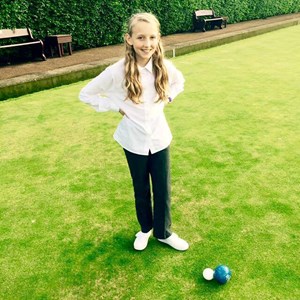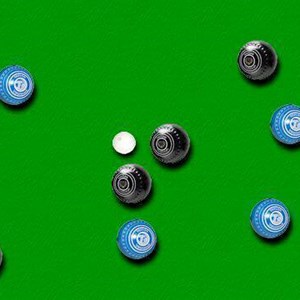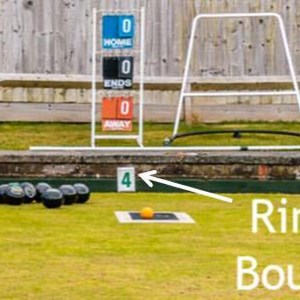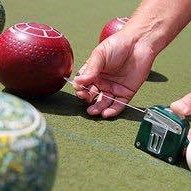Guide to Playing Bowls
Introduction
This page is aimed at the bowls beginner and those who are considering trying their hand and perhaps wondering what the game's all about. Of necessity the following outline of the game is a much simplified account of the basic points and this link will take you to a page of short videos that illustrate many of them.
Objective
The aim of the game is simple: to get your bowls, either as an individual or team, closer to the target than your opponent. The target is a small white or yellow spherical ball known as the jack (pictured below with a bowl and one of our junior members) and you score one shot (i.e. a point) for each bowl closer to the jack than your opponent's nearest bowl. The graphic below shows a position after an end in singles where each player has delivered their four bowls. The person playing with the black bowls has two bowls closer to the jack than the nearest blue bowl and therefore scores two shots.
Playing area
Bowling greens are normally square, but may be rectangular, up to 40m in length and surrounded by a ditch and bank. Although usually of grass, some greens are made from synthetic material. The green is divided into parallel rectangular playing sections, usually six or seven in number, known as rinks and indicated by a central number on the bank where vertical markers also indicate the rink's boundaries. The photograph shows the markings of rink 4. Click the photo to enlarge it.
Bowls
Although bowls are sometimes called woods from their original source, the vast majority produced nowadays are made of a high density plastic. Bowls are manufactured so that the biased side is slightly heavier than the other. When rolled, the bowl initially starts on a straight path, but as it slows down the effect of the bias becomes increasingly apparent is it curves towards the target. Bowls are sold in sets of four and are available in a wide range of sizes, of different weights and biases, and an increasing number of colours and effects. There's a useful guide to buying bowls here.
Formats
One advantage of bowls over many games is that it can be played between different numbers of people. Singles involves one person playing another, each player using four bowls; pairs is played between two teams of two, each player again using four bowls; triples between two teams of three, each player having three bowls; and fours (sometimes confusingly called 'rinks') involves two teams of four, each player bowling two bowls. Games between two sides are a core feature of bowls and are usually played between teams of four or three players, often with mixed sexes, and the winning team decided by the highest aggregate score.
Start
All the games outlined above start the same way: the jack, having been legally delivered up the green by one of the players standing on a small rubber mat, is centred. Players on opposing sides then take their turns in alternately delivering their bowls trying to achieve their objective.
Ends
When the players from both sides have delivered all their bowls in one direction and the score has been agreed, an 'end' has been completed. The next end finishes when all the bowls have been played in the reverse direction and the score agreed.
Scoring
With the exception of singles, which is normally decided by the first player to score 21 shots, other formats are determined by the score after the requisite number of ends have been played. Pairs is usually decided over 21 ends; triples over 18 ends; and fours over 21 ends.
Duties
In team games, each player has specific responsibilities. In fours, for example, the lead (the first person to bowl) places the mat, delivers the jack and ensures that it's centred. The third player measures disputed shots with a special bowls measure (pictured below). The fourth player is the skip (short for skipper) who has sole charge of the team in dictating the strategy and tactics.
Why Play Bowls?
Unlike many sports, bowls is easy to grasp and most beginners achieve fairly quickly a standard good enough to enjoy playing. And what other game allows all ages and both sexes to compete on level terms whilst also providing a low impact, therapeutic form of exercise.



